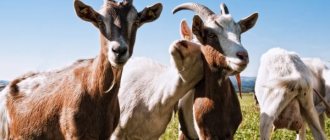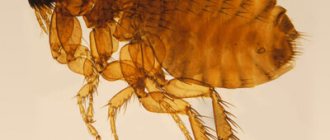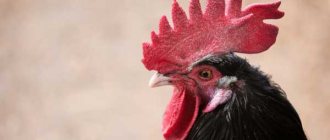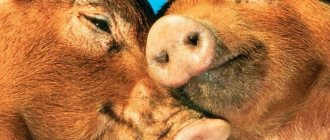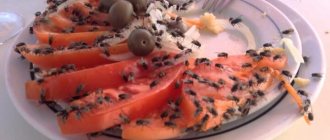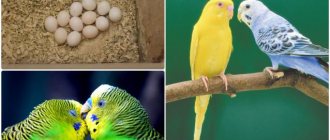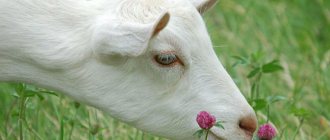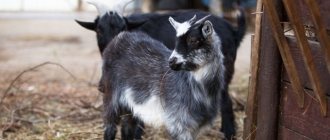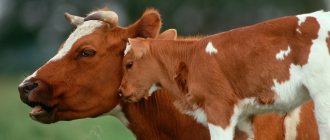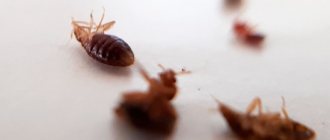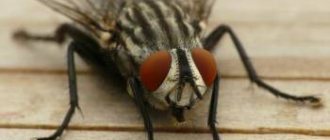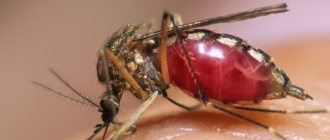Goats are seasonal animals. Their fertilization and lambing are closely tied to the changing seasons. To obtain offspring and milk, it is important to know how many days a goat walks and what the frequency of hunting is. Otherwise, you can miss the time of mating and be left without anything for a whole year.
A goat with a kid or is it still a goat?
Frequency and duration of hunting
Puberty in goats is early. Most individuals show the first signs of hunting already at five months of age. As a rule, this occurs at the end of August or beginning of September. A month before the expected hunting days, it is important to divide young animals into boys and girls and then keep them separately.
Early, unwanted insemination will interfere with the normal development of the goat's body. The offspring will be single. The kid is born small and lags behind breed standards in growth. In some cases, early lambing can lead to the death of the animal.
Goat hunting lasts several days. Occurs every three weeks. Animal behavior is changing. Signs of heat are not difficult to notice even for a novice goat breeder. How long a goat walks is determined by the time of year. In winter, the frequency of hunting increases by 3-5 days.
The duration of estrus ranges from 1 to 3 days. The best time for fertilization is the first 12-14 hours of hunting. Mating is carried out twice, in the morning and in the evening.
You can count how many times a goat walks a year. The seasonality of the fertile cycle is manifested in the fact that the goat “walks”, as a rule, from mid-August to the end of January - five months or 150 days. During this time, estrus occurs 6 to 7 times. From mid-winter to late summer, goats show no interest in males, reacting to their approach with aggression.
When to expect offspring
If the mating was successful and the female managed to impregnate the goat, then offspring should be expected within five months. If mating does not produce the expected results, it should be repeated after three weeks, during the period when the individual resumes hunting. It is possible to determine that an individual is “in position” by the following signs:
- 21 days after mating there is no repeat estrus.
- The goat's appetite increases.
- The animal behaves calmly and reservedly, jumps and plays less.
- Instinctively protects the fetus - when the belly is touched, it presses it under itself and tries to recoil.
In order to confirm pregnancy, monitor the condition of the mother and fetus, as well as to select the necessary set of vitamin supplements, it is recommended to consult a veterinarian.
Sometimes, to control reproductive processes in the goat’s body, owners create a so-called “hunting calendar.” This event is carried out to monitor the frequency of estrus in the animal and their regularity. This can be a calendar in the literal sense of the word or a notebook in which the owner writes down the dates of estrus and mating, the frequency of hunting, and the timing of pregnancy.
Thanks to the right approach, any animal will not suffer, its health will remain unchanged, and the owner will receive an addition in the form of young goats.
How to recognize heat in a goat - the main signs
The arrival of mating time and how long the goat walks are determined by changes in the animal’s behavior.
What are the signs when a goat is walking:
- Refusal to eat. The goat may not eat the usual portion of feed, leave the hay, or refuse the treat. Not all animals do this, so you should focus on a set of signs. On the other hand, refusing to eat may indicate illness.
- Restless behavior. Signs of anxiety are identified by frequent (sometimes continuous) bleating when all basic needs are met. If the goat is healthy, fed, watered, and its environment has not changed, then most likely it is in heat.
- Wags his tail. A quick wag of the tail raised up almost always indicates the start of the hunt. The animal begins to wag its tail especially actively when it sees its owner. In this case, the general appearance of the goat can be defined as “begging.”
- Swelling of the vulva. If you look under the animal's tail, the vulva will be swollen, slightly pinkish and moist. During periods when the goat is not “walking,” its vulva is closed, dry, and the labia are folded inward. Here it is important to know what the genitals of a goat look like at rest.
- The goat "crouches". If you press your hands on the goat's back during a supposed heat, it will crouch down and raise its tail. In their normal state, goats react aggressively to such liberties, trying to wriggle out and run away.
It is impossible to say exactly how to understand that a goat is walking. This manifests itself differently in each animal. Some goats do not show clear outward signs of heat.
Baby goat with a hat
What are the signs to tell if an animal has gone on a spree?
Before the first mating, a sexually mature female must gain sufficient weight (slightly more than 30 kg). This indicates that the animal is fully mature and ready to bear offspring. Goats weigh this much at 7–9 months.
You can tell that an animal is walking by signs such as:
- Redness and slight swelling of the external genitalia.
- Previously peaceful females may become irritable and aggressive, and begin to restlessly explore the area.
- Animals constantly sniff, trying to catch the scent of a male, and wag their tails.
- In some cases, the goat loses its appetite.
- Discharge from the genitals.
Important! In some females, heat occurs with virtually no signs. If you suspect the onset of estrus, you need to pat the goat on the back. If the time has come, she will start wagging her tail.
Why don't goats go into heat?
If there is a buck nearby, the absence of estrus may be due to a previous pregnancy. Goats only need one minute to mate.
A goat's lack of desire to mate may be due to several factors. Namely:
- Presence of worms. Periodic, once every six months, worming of goats is mandatory. Infection with parasites depresses the body and sharply reduces milk yield. The animal loses a lot of weight, but the goat’s appetite can remain good.
- Poor nutrition. The lack of vegetables, grains in the diet, and poor hay lead to exhaustion of the dairy goat. To compensate for this, the body postpones reproduction until better times.
- Short daylight hours when kept indoors.
- Obesity. An overweight animal either does not come into heat or is not fertilized during mating. In the second case, the goat walks several times.
The lack of hunting in a goat should cause concern among the owners. Perhaps the animal should be shown to a veterinarian or errors in caring for the goat should be corrected.
And what to do if the goat is not hunting?
- You should start by adjusting your diet. For fattened animals, grains are removed, with an emphasis on hay or grazing. Weak goats are fed with oats and bran, adding tetravit once a day.
- Check to see if the time for administering anti-parasite drugs has been missed. A veterinarian is invited to determine diseases.
- If you cannot determine how often the goats walk, then do a test mating. It is possible that your animals are in latent heat. This feature is passed on through the maternal line.
Carrying out mating
As a rule, goats come into heat in the fall. The peak of their activity continues until the end of December. This period is considered the most favorable for mating, since babies are born five months later, just as warmer weather approaches. Also, spring and summer are the most vitamin-rich times. From fresh herbs and plants, goat kids receive the vitamins and microelements necessary for healthy growth and development.
Features of sexual intercourse
Mating occurs on an instinctive level, as a result of the interaction of hormones in individuals of the opposite sex. Like other living creatures, sexual intercourse in goats has a number of features. It does not last long, from three to ten seconds. This is due to the structure of the male reproductive system.
When sensing the specific odor emitted by a current female, a male representative instantly gets an erection. Sperm from the scrotum enter the tube-shaped openings and are in “waiting mode.” During penetration (penetration into the genitals), the goat only needs one or two frictions to release sperm into the vagina.
For a number of reasons, fertilization can be carried out artificially. This method involves injecting sperm into the goat's genitals using a special syringe. The procedure is performed by a doctor, usually at home. The following reasons may serve for artificial insemination of a female:
- Psychological problems - the individual has phobias and intolerance to natural mating.
- Inability to find a suitable male in a short period of time.
- Pathologies or physical characteristics of the goat’s body that prevent natural mating.
Note. If it is possible to give birth to a goat naturally, it is recommended to give preference to this method, since when an organ is inserted, it produces hormones necessary for its normal functioning.
Stimulating a goat for hunting
- If the goat does not come into heat on time, but is healthy, then drug stimulation is used. Prescription of the drug and dosage are the responsibility of the veterinarian. In large farms, estrofan is often used for this purpose. Injections are given intramuscularly, 0.7 ml, morning and evening. Estrus occurs after 10 days.
- In private households, they limit themselves to tampons soaked in progesterone. They are inserted into the goat's vulva.
Note! It is impossible to use drug stimulation of oestrus if there is any doubt about the goat’s pregnancy. This leads to miscarriage.
Mating process
If the male is in the appropriate condition, and the female is by all indications ready for fertilization, conception begins.
The goat begins this action with pleasure. The process itself is not long; it usually takes only a few seconds. It is possible to understand that mating has occurred by a strong push from the male, after which the goat slightly hunches over.
If after two to three weeks there are no signs of pregnancy, it is worth repeating the procedure. In this case, you can change the male. It is important that the coating is carried out in a quiet, calm environment.
Rarely does a goat fail to become pregnant and bear offspring. It happens that the goat reaches the period of fertilization, but the hunt does not come. Then the owner needs to intervene: lock the goat and goat in the barn for a day or even two.
Before mating, you should not load the male. In one day he is able to cover no more than two females. You also need to pause after each coating (5-6 hours).
When the female is in heat, but constantly runs away from the male, it means that the time has not yet come to cover her. There is another option: the goat is still too young, and its smell is not so strong to attract the goat. Accordingly, it is better to mate with a goat that is older than one and a half years.
Family ties should be excluded during mating. Otherwise, the resulting kid will be defective (body defects, deformity). There is also a possibility that the baby, although born normal and healthy, will become less productive with age.
We also note that the coating is unsafe. Various diseases and viruses can be transmitted from animal to animal. Therefore, it is better not to use other people’s animals for these purposes. It is more advisable to keep them on your own farm, even if there are only two females per male. This is the only way you can be sure that the milk the goat gives is safe.
How to induce heat in a goat without using medications
Not all owners agree to inject goats with hormonal medications. If there are no signs of estrus, then the goat can be stimulated as follows:
- Place the goat in the room overnight. Its smell has a stimulating effect on the female. At the same time, there is no need to let the animals get close to each other, since the active male will torture his “girlfriend.”
- Add sprouted grains, flax or soy to your daily diet.
- Increase daylight hours to 12 hours. This measure is necessary in late autumn and early winter.
- When making hay, some of it is rubbed on the skin of a goat to preserve the smell. Feeding such a supplement is a proven folk remedy for stimulating estrus in goats.
Where's my goat?
Technology
Let's look at how goats are mated. The process itself lasts only a few seconds. To guarantee the fertilization of the female, you should follow a few simple rules:
- choose a quiet place for mating, a calm environment;
- the goat is brought to the female and allowed to mount, making sure that in addition to several small pushes at the end there is one strong one;
- after the final push, the goat should hunch over; if this does not happen, the mating is repeated;
- after the first mounting, the male is allowed to rest for 20-25 minutes and the process is repeated;
- in one mating, a goat can only breed two times, then he needs a break of at least 6 hours (covering earlier is useless - there will be no sperm in the testes, it takes time to form).
In goats, the reproductive cycle lasts from 17 to 23 days. Its violation serves as a signal about improper nutrition of animals, lack of microelements or vitamins.
How many kids can one goat give birth to?
Goats are characterized by multiple pregnancies. One kid, as a rule, is born by young animals that are fertilized too early.
A mature female bears 2-3 kids without any damage to her health. A larger amount has a negative impact on the development of the offspring. The kids will be born small and weak. It often happens that one of them becomes unviable.
How to determine if a goat is pregnant
It is impossible to accurately determine pregnancy on your own in the early stages.
The main sign is the absence of another heat. 3 weeks after mating, you should carefully monitor the behavior of the goat. If the animal does not show concern, then, most likely, fertilization was successful.
There are some indirect signs of pregnancy that experienced breeders use. This:
- A noticeable increase in milk yield a couple of weeks after mating, followed by a sharp decline below the initial level.
- The covered female becomes calmer and lies down more.
- Asymmetrical belly. A noticeable increase in the abdomen occurs at 3-4 months. External examination does not give an accurate picture. The movement of the kids can be mistaken for the work of the goat's stomach.
- The vulva becomes enlarged and remains slightly swollen. However, its color does not change.
- An accurate result can be obtained early on by ultrasound.
How to determine severity?
In most cases, mating ends in pregnancy. To provide special care to a goat, the breeder must be able to determine the pregnancy of an individual. This can be done in several ways:
- Laboratory. The veterinarian checks for pregnancy using an external examination, insertion of a sterile speculum and ultrasound. The latter method is more accurate and allows you to find out the timing.
- Through control on the home farm. It is convenient to monitor the condition of the female during milking. When pregnancy occurs, the udder enlarges and the skin around the vagina becomes smooth. The animal should behave calmly and eat well. In the later stages, you can notice the asymmetry of the abdomen, the sides are rounded.
- According to popular belief. A few drops of milk should be placed in a glass filled with water. If the milk sinks to the bottom, there is no pregnancy. Dissolution of the product indicates successful coverage.
- Trial mating. 21 days after mating, the sire must be brought to the female. If she chases him away, pregnancy may be suspected. Otherwise, mating will occur again.
Reference! In some cases, the pregnancy may be false. In this condition, the udder swells and fluid accumulates in the uterus, which splashes out during childbirth. It is impossible to diagnose pathology without ultrasound.
Proper care of an animal after birth
A healthy goat lambs without human intervention. The kids appear one after another, with a break of a couple of tens of minutes. Veterinarians allow 4 hours to separate the placenta. Next, the goat’s uterus begins to close. Remains of the placenta can lead to the death of the animal.
If during this time everything does not work out, then you should help the goat by calling a specialist.
Forced separation of the placenta is carried out manually by inserting the hand into the uterine cavity. The animal must be in an upright position.
To stimulate uterine contractions, the goat is milked immediately after the kids emerge.
If the lambing is successful, the queen is given water with sugar and hay. The afterbirth is removed, the bedding is changed, and the animal is allowed to rest for an hour and a half. After which they offer clean water. You should drink at least once every 3-4 hours. Usually this time coincides with milking hours in the first 3 days. There should be hay in the feeder at all times.
Feeding after lambing is as follows:
- For the first 3-4 days, bran is given to stimulate the functioning of the stomach.
- From the fifth day, concentrates are added, introducing them in small portions.
- After a week, the goat is transferred to normal food. The daily diet of a dairy goat includes hay, branches, concentrated and succulent feed (raw vegetables).
- Milking goats is carried out with an increase in concentrated feed. They are given at least 3 times a day.
Note! You don’t have to worry about overfeeding a goat, since these animals, having had enough, leave what they haven’t eaten in the feeder.
Kids require no less attention during lambing. Necessary:
- Clear the mouth and nasal passages of any remaining membranes and amniotic fluid.
- Wipe off.
- Place in a warm place.
- Feed with colostrum.
- The frequency of feeding the kids coincides with milking the goat. In the first days after lambing, this is 4-5 times. After a week of intensive milking and feeding, you can switch to a three-times-a-day regimen.
Kids should be fed with fresh or warmed mother's milk. The offspring are not allowed near dairy goats even for a few days. To make the sucking reflex go faster, the kids are fed from a small container.
Baby goat for a walk
Which goat is suitable for mating?
For effective and high-quality fertilization, a young and strong male is chosen. To breed a female for the first time, it is better to choose a calm, unhurried animal that has experience in fertilization. For experienced individuals, dexterous breeders at the peak of their activity are suitable. The general requirements for all males are:
- excellent physical health;
- age from 1.5 to 5 years;
- keeping it clean;
- large build;
- origin from healthy parents.
Before mating, in order to achieve the most positive result, the male should be properly prepared.
- It is necessary to show the goat to a veterinarian. A specialist examines the animal for infectious and hereditary diseases. If necessary, vitamin supplements are prescribed in the form of solutions or injections.
- For 2-3 months before mating, it is necessary to carefully monitor the diet of the inseminator. The goat should receive a variety of food supplied with all the necessary vitamins, minerals and nutrients.
- You should take care of the conditions of detention. The male should be in a warm, dry barn, protected from leaks and drafts.
- It is necessary to monitor cleanliness - the room in which the goat lives must be clean at all times. The shed needs to be cleaned once a week. Every three to five days, the bedding is changed - the old straw is removed from the room, and new straw is laid to replace it.
It is also important to monitor the cleanliness of the animal itself and, if necessary, remove dirt from the fur with a special brush. Once a month you can wipe the back and sides with a damp cloth
During the cold period, this procedure is carried out in a warm, dry room.
When choosing a partner, it is advisable to take into account such a criterion as a positive fertilization experience in previous matings.
How to select a manufacturer? Finding a good goat
A goat “for breeding” must have distinct characteristics of the breed, be large and active. Sexual maturity in males occurs at 5 months. By autumn, the goat is quite ready to fulfill its purpose.
When purchasing, you should find out the purity of the offspring. In private farmsteads, related matings are often practiced, due to which the breed gradually degenerates.
Signs of a good sire (good goat):
- Short powerful neck.
- Neat head.
- Developed breasts.
- Wiry back.
- Short straight legs.
- Thick beard.
- Developed genitals.
- Height at the withers is about 80 cm.
- Weight about 70 kg.
A mature producer is used for about 4 months a year. The rest of the time he is on a maintenance diet. A month before the expected mating, the goat is transferred to a fortified diet.
Preparing goats for mating
Males reach sexual maturity at six months, but they are allowed to mate only at one year of age. Early exploitation negatively affects the development and health of young producers. The offspring from such a goat will be weak and frail. Males up to 6 years old are used for covering, then the animal is culled. In exceptional cases, when the manufacturer has particularly outstanding qualities, it can usually be used for up to 8 years.
Preparation of breeding goats for mating begins 1.5 months before the start of the campaign. They are transferred to balanced, enhanced feeding from high-quality feed. Much attention is paid to the content of protein, vitamins and microelements in the diet.
During the period of preparation for mating, goats are checked for sexual activity and sperm quality. Young breeding males allowed into mating are often inactive for the first time, so they are isolated and separated into a separate group and are taught to mount an artificial vagina.
Comparison of reproductive performance of bucks and bucks
Quality of sperm production and fertilizing ability of sperm from Saanen bucks at different ages (source).
| Indicators | Experimental animals | |
| Goat, 7 months | Goat, 4 years old | |
| Ejaculate volume, ml | 0,9±0,07 | 1,3±0,06 |
| Sperm motility, points | 8,0±0,33 | 9,0±0,08 |
| Concentration, billion/ml | 2,8±0,11 | 3,2±0,14 |
| Inseminated goats, n | 11 | 11 |
| Number of maddened goats, n | 9 | 10 |
| Kids received, n | 16 | 18 |
| Fertility,% | 81,8 | 90,9 |
| Fertility, % | 177,8 | 180,0 |
When can a female be born? Determine the goat’s readiness for motherhood
A goat can give birth to its first offspring at 10-11 months. However, early mating has a negative impact on the goat’s milk production, its health and the quality of its offspring.
The optimal age for impregnation of goats is considered to be one and a half years. By this time, the active growth of the animal ends, the female is active and manages to accumulate a sufficient supply of nutrients for the period of pregnancy.
The fertile age of goats, if well maintained, can last up to 12 years. But fertilization after the age of nine risks complications during childbirth. Often in old females the placenta does not pass well. Kids are born weakened and with developmental defects.
Choosing a partner
If the farm does not have the task of obtaining breeding young animals, then the breed of the goats does not matter. The animal must be healthy - this is the main criterion. Males are ready to breed effectively at the age of 6 months, but it is advisable to allow them to mate no earlier than 8 months.
To obtain purebred kids, a male is selected that meets the following requirements:
- be unrelated to the female (inbreeding is allowed in goat breeding, but only on the recommendation of a specialist);
- have ancestors with high milk qualities;
- be verified by offspring (have adult daughters with good milk yield).
In dairy goat breeding, it is for the amount of milk in the offspring. Therefore, the goat must exceed or be no lower than the female goat in terms of milk production from the mother and grandmothers.
Occasional period
After all the signs indicating a hunt appear, it is necessary to carry out a random process. Immediately before it, it is recommended for the queen and the producer to conduct a veterinary examination to identify possible deviations in the health of the animals.
An examination of the genital organs of bucks and female goats is mandatory.
In some cases, you may encounter the fact that the queen begins to drive away the producer. This behavior indicates that the time for mating has not yet come or the deadline has already passed.
It is better to carry out mating in a quiet place where nothing will disturb the animals. The goat is usually held by the horns while the producer does the cage; the coating itself takes a few minutes. The process is repeated after 20 minutes, this time is spent on restoring the goat.
There are several types of mating:
- natural - with the participation of the manufacturer;
- artificial - injection of sperm from a goat by a veterinarian.
Natural coating also has its own types:
- Free. Both goats and producers are united into one herd. Any male can cover any goat he likes when it comes into heat. The option is distinguished by its simplicity, because the owner of the animals does not need to monitor the start of the hunt. The disadvantage of the method is that it is almost impossible to understand which particular producer impregnates the goats. It is common for some goats to be lazy, making one or two cages per year.
- Harem. From the name you can understand that a herd of goats uses one producer. Due to the lack of a replacement, he will have to cover all the goats. A disadvantage may include a decrease in the number of sperm in the seminal fluid due to frequent mating, which leads to non-fertilization of some queens. To avoid breakdowns, it is recommended to give the goat rest.
- Manual. Occurs under the control of the owner. The goat is fixed in the pen, then the producer is allowed in, who makes several cages, and then the animals are returned to separate rooms. If the mating did not occur the first time and the goat came into heat again, it is necessary to repeat the mating after 12 hours.
Synchronization of the reproductive cycle
Synchronizing the reproductive cycle in goats requires some effort from the breeder.
Algorithm of actions
We offer simple manipulations to synchronize the sexual heat of goats.
Follow these steps:
- Before synchronizing the entire livestock, review the goat menu and switch all pets to balanced and rational feeding.
- Check for the presence of helminths and other harmful parasites, eliminate foci of infections and strengthen the animals’ immunity by any means.
- Give the females vitamins, for example, tetravit.
- Introduce vitamin root vegetables, stimulants and green hay as a top dressing.
- Certain plants have an excellent stimulating effect on sexual desire: flax, soybeans, nuts.
- Use the drug Estrofan. The effect of its use occurs on the 11th day after injection.
- In the most severe situations, medications are required that correct the hormonal levels of females in combination with Surfagon.
These simple tricks and medications help to get healthy kids and restore the reproductive function of goats in case of synchronized heat of the entire herd.
All medications are prescribed only by a veterinarian, taking into account the age of the goat, the degree of development and the number of previous lambings. It is important to involve a specialist, and not rely on your own intuition and advice from neighbors.
When the reasons why a goat does not walk and methods for overcoming the problem are known, breeders can personally improve the reproductive function of their pets and increase the total number of livestock.
